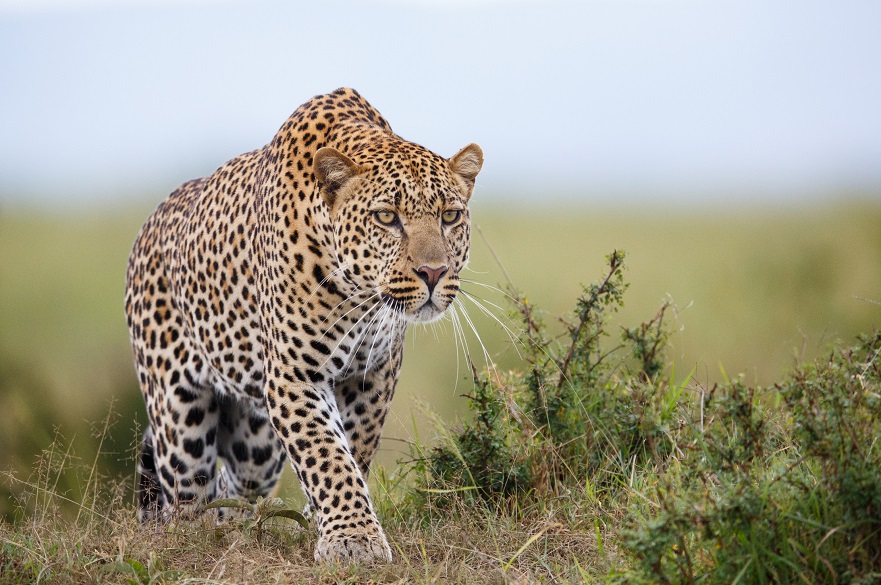Leopards from Africa and Asia are genetically distinct, DNA analysis of museum specimens reveals
A small group of leopards migrated to Asia about half a million years ago following their evolution in Africa, a new study suggests.
By Dave Rogers | Published on 12 April 2021
Categories: Press office; Research; School of Science and Technology;

An international team – involving scientists at Nottingham Trent University, the University of Cambridge, University of Leicester and the University of Potsdam in Germany – carried out genetic analysis of historical specimens stored in natural history museums as part of the study.
While they both have spots, the researchers discovered a striking genomic distinction between leopards living in and Asia and Africa, which diverged around the same time as Neanderthals and modern humans.
Asian leopards are more genetically separated from African leopards than brown bears are from polar bears, the researchers found.
While there has been some population exchange around the Near East, the genetic differences between African and Asian leopards have been maintained since that first migration event 500,000 to 600,000 years ago.
Genetic analysis typically requires fresh tissue samples, but analysing the historic museum specimens allowed the team to recover genome information from populations that have previously been driven to extinction over a number of decades.
The researchers were able to obtain nuclear genomic data – the complete set of DNA – from leopards across their current and historical distribution, revealing new details about their global population dynamics.
Since their separation, Asian leopard populations have experienced less genetic variability and gene flow than their African counterparts – most probably due to geography and greater dispersal across the continent.
Leopards – which are classified as a threatened species – are the only big cats still widely distributed across Asia and Africa and are often found in close proximity to humans, resulting in extreme habitat losses and severe population reductions.
Despite this extensive encroachment by humans on leopard habitats, however, the historical samples did not necessarily show a greater genetic diversity than the more modern samples included in the study.
This suggests that, while humans have driven some local leopard populations to extinction, the impact of humans on the species as a whole has not been severe enough to have an effect on the entire genome.
“Despite the fact that they are the most widely distributed big cats, the evolutionary development and population history of leopards across Africa and Asia has not been studied with genomic tools before now,” said Dr Axel Barlow, an expert in palaeogenomics and molecular bioscience in Nottingham Trent University’s School of Science and Technology.
He said: “Our results have highlighted marked genetic differences between African and Asian leopards, that Asian leopards originated from a single out-of-Africa dispersal event, and that the distinctiveness of leopards on the two continents has been maintained.”
Dr Johanna Paijmans, Research Fellow at the University of Cambridge and Honorary Fellow at the University of Leicester, said: “While they both have spots, these leopards are quite different when looking at their DNA. Given their mobility, it is surprising that they have remained so distinct and do not carry more shared genetic material with one another.
“Our study demonstrates that many more exciting genetic discoveries could be hidden among the shelves of natural history museums around the world.”
The research is published in the journal Current Biology.
Notes for Editors
Press enquiries please contact Dave Rogers, Public Relations Manager, on telephone +44 (0)115 848 8782, or via email.
Nottingham Trent University (NTU) was named University of the Year 2019 in the Guardian University Awards. The award was based on performance and improvement in the Guardian University Guide, retention of students from low-participation areas and attainment of BME students. NTU was also the Times Higher Education University of the Year 2017, and The Times and Sunday Times Modern University of the Year 2018. These awards recognise NTU for its high levels of student satisfaction, its quality of teaching, its engagement with employers, and its overall student experience.
The university has been rated Gold in the Government’s Teaching Excellence Framework – the highest ranking available. It is one of the largest UK universities. With nearly 32,000 students and more than 4,000 staff located across four campuses, the University contributes £900m to the UK economy every year. With an international student population of more than 3,000 from around 100 countries, the University prides itself on its global outlook. The university is passionate about creating opportunities and its extensive outreach programme is designed to enable NTU to be a vehicle for social mobility. NTU is among the UK’s top five recruiters of students from disadvantaged backgrounds and was awarded University of the Year in the UK Social Mobility Awards 2019.